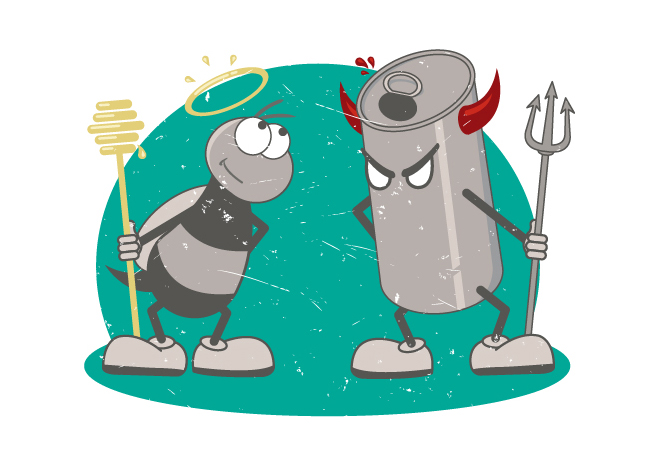
Cut out sweets? Here’s why certain kinds of sugar aggravate your system. While others simply taste good.
By Steve Kaufman
In my previous update, I mentioned that Dr. Michael Cassaro of Painless Living is a strong advocate of less pain through smarter eating.
“There are a lot of treatment interventions in medicine,” he said. “Surgery, prescriptions, devices. I use nutrition as a treatment intervention. In fact, I believe it’s one of the most powerful.”
We all say we want to eat better. Maybe to lose weight. Maybe to live longer. Maybe to improve our immune systems. Maybe to improve the planet. But how, exactly, will changing my diet affect my pain?
Hang on, some of this might sound like your high school biology class.
It starts, perhaps not surprisingly, with sugar – which, unfortunately, shows up all over our supermarket shelves. “Market research shows that people like the taste of sweet,” said Cassaro. “So manufacturers find ways to sweeten up their foods.”
But using plain cane sugar is fairly expensive. Beet sugar is less expensive. High-fructose corn syrup is the least expensive – and the most effective. At least, it’s the sweetest.
Look at your packaged food labels: Catsup. Spaghetti sauce. Cereal. Soups. Crackers. Peanut butter. Coffee creamers. Salad dressing. Baking ingredients. Almost anything that’s pre-made.
“Catsup used to be made primarily from tomatoes,” Cassaro pointed out. “Now, tomatoes may or may not be the first ingredient. High-fructose corn syrup will certainly be up there.”
I just looked at the catsup in my pantry. “Tomato concentrate” is first, “high-fructose corn syrup” is second.
Fructose is the bad guy! It’s one-half of a sucrose molecule. The other is glucose. But fructose is not friendly to our systems.
“When we ingest sucrose, our body divides it up into glucose and fructose,” Cassaro explained. “The glucose probably doesn’t cause much harm. The fructose, on the other hand, causes a lot of harm. Glucose is a fuel, burned for energy. Fructose has to be broken down first. And, since sedentary lifestyles don’t need as much fuel and break down fructose more slowly, it gets stored as fat. It raises blood pressure and uric acid and changes the way our airways react, which leads to allergies and asthma. It can also lead to heart disease and other degenerative diseases.”
What about its effect on pain?
“Fructose causes inflammation, both by increasing uric acid and by lowering the body’s pH level, which is a scale of acidity.
“Also,” said the physician, “the fat, which comes from fructose and other dietary factors, is not just a storage depot. It’s metabolically active. It releases a lot of metabolic products into your body, including hormones and inflammatory mediators. Fructose is 200 times more likely to promote pain in our joints and nerves than an equal amount of glucose.”
Interestingly, dietary sweet things like honey and pure maple syrup are the perfect antidote to those fructose-laden products the food industry thrusts at us. Primarily, they have lower concentrations of the insidious fructose. “Honey has dozens of different types of sugar,” said Cassaro, “but it’s a natural product with relatively low amounts of fructose. On the other hand, it’s high in glucose. And it tastes good, so it’s an easy switch for people looking to reduce their dietary sweeteners.”
Maple syrup has no fructose. None! Zero! And because the process of concentrating the syrup from the original sap extrudes the water out of it, you’re left with a sugar that’s almost all glucose.
Also, said Cassaro, there will almost always be a difference between products that are naturally occurring and synthetic products produced in a lab. “Even if they seem identical, the fact that something came from a factory rather from than a plant means there will be impurities, and aspects where reactions might not be quite the same between some of the molecules. A synthetic is never as high-quality as a natural product.”
It’s the old dictum: Try not to fool Mother Nature.
Were you one of those people who dozed off in biology class? Or chemistry? I’m afraid I was. And there’s much more to say about my doctor’s approach to the food we ingest and the pain that results.
Like bread. Pasta. Rice. Artificial sweeteners. Diet Coke, and its relationship to Michael J. Fox’s Parkinson’s Disease.
You may not think you’ll get excited about a discussion of hydrogenated oils. But I promise you, if you’re looking to reduce those flashes of pain that come at you every day, seemingly out of nowhere, you’ll want to read the next few installments of this column.
EDITOR’S NOTE: In 2016, Steve Kaufman was asked to write an informational piece about Dr. Michael Cassaro of Painless Living in Jeffersonville. Unbeknownst to us, Steve has suffered from chronic pain for years and sought out Dr. Cassaro’s pill-free treatment of pain on his own. He has since agreed to chronicle his journey in Extol and ExtolMag.com.




















